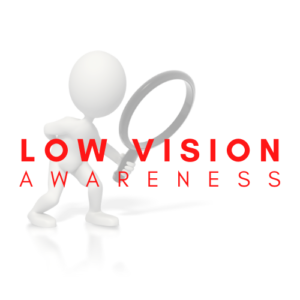What is Low Vision?


There are a range of eye conditions and injuries that can cause one of the forms of impaired vision:
- Loss of central vision: This is when there is a blind or blurred spot in the center of one’s vision.
- Loss of peripheral (side) vision: The inability to see objects and movements outside the direct line of vision.
- Night blindness: The inability to see in poorly lit areas.
- Blurred vision: Objects both far and near appear out of focus
- Hazy vision: The entire field of vision appears to be covered with a hazy film or glare.
Living with Low Vision
There is no single visual aid to solve the myriad of challenges faced with impaired vision.
Several devices are available as aids to improve vision, and many of them are task-specific for either near or for distance optical tasks.
For near optical tasks (e.g. reading, computer) there are handheld digital magnifiers and digital desktop magnifiers.
Electronic magnifying systems are helpful for reading and for personal grooming tasks. They have a camera system that records and then displays a magnified image on a monitor. Some cameras in these systems can rotate 360 degrees, or close to it, and they allow viewing of an entire room. There also are hand-held models that capture images on the underside and magnify and display them on the monitor on the top of the device and are useful while traveling. Hand-held monitors range from 3.5 to 13 inches.
For distance tasks such as walking, watching TV, socializing, or driving there are bioptic telescopes, which can enable the severely nearsighted to drive and allow for other distance-vision type tasks.
Bioptic lens systems have allowed many people to continue to drive even though they fall below the legal visual acuity limit (20/40-20/60) to drive an automobile. Most states permit persons with mild-to-moderate central vision loss, and who have intact peripheral vision, to apply for restricted driving privileges that require the use of a bioptic lens system while driving. Many states also require completion of low-vision driver education training as a license requirement.
Before You Purchase
Have a low-vision examination with an optometrist or ophthalmologist who has had additional training with these specific devices and discuss the various aids that would work best for your particular type of impairment. Many specialists have loaner programs or allow hands-on experience with the different models of aids so you can decide which device works best for you.


